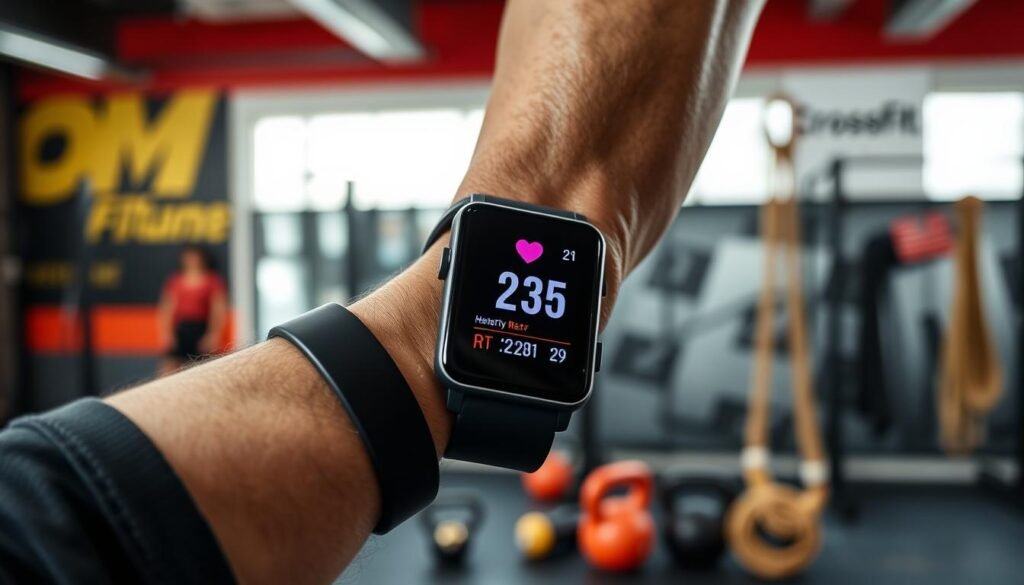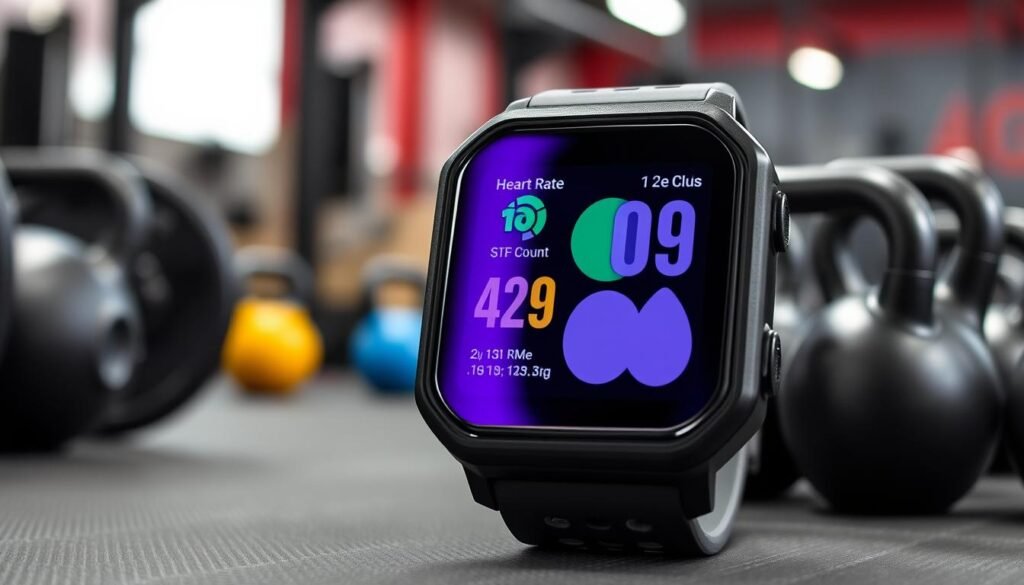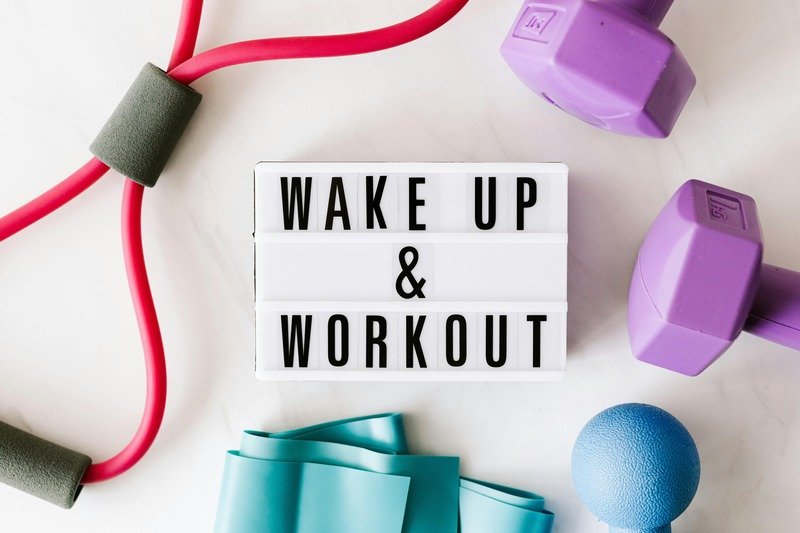We independently test and review fitness products using a research-based approach. If you buy through our links, we may earn a small commission at no extra cost to you. Read our Disclosure
Fitness trackers can change the game for CrossFit athletes. They help track progress, find areas to improve, and adjust training. This can take an athlete’s performance to new heights. Gyms that use these tools see a 92.1% boost in revenue, showing their value.
Using fitness trackers, athletes get insights into heart rate, distance, and calories burned. This helps them fine-tune their workouts and reach goals faster. About 70% of members feel motivated by tracking progress together, showing its power in CrossFit.

The right fitness tracker opens up a world of data for CrossFit athletes. It helps them track progress and stay motivated. This way, they can reach their fitness goals and improve their performance. Next, we’ll look at the benefits, how to pick the best tracker, and tips for using it to its fullest.
Understanding the Role of Fitness Trackers in CrossFit Training
Fitness trackers are key for CrossFit athletes, giving them insights into their performance. They use wearable technology to track progress and find areas to get better. Motion sensors on Olympic bars help analyze lifting technique, improving form and performance.
Using fitness trackers in CrossFit training offers many benefits. Athletes can get online coaching and feedback, staying motivated and accountable. They can track heart rate, distance, and calories burned, understanding their performance better. This helps them make informed decisions to enhance their training.

Key benefits of fitness trackers in CrossFit training include: * Better performance tracking * Increased motivation and accountability * Personalized coaching and feedback * Detailed analysis of lifting technique Fitness trackers help CrossFit athletes improve their performance and reach their goals more effectively.
Choosing the Right Fitness Tracker for CrossFit
Choosing the right fitness tracker for CrossFit can greatly improve your performance and training. With many options out there, picking the best one can be tough. Some top picks include the Garmin Venu 3, Fitbit Charge 6, and Amazfit Bip 3 Pro.
When picking a fitness tracker for CrossFit, think about accuracy, durability, and how well it fits your training goals. For example, a tracker that gives detailed heart rate and distance analysis is great for endurance athletes.
Here are some important features to look for in a fitness tracker for CrossFit:
- Heart rate monitoring
- GPS tracking
- Water resistance
- Long battery life

By looking at these factors and features, you can find the perfect fitness tracker. It will help you improve your performance and meet your training goals in CrossFit.
Essential Features for CrossFit Performance Monitoring
When it comes to tracking CrossFit performance, there are key features athletes should look for. These include heart rate tracking, recognizing movements and exercises, and durability. Wearable technology helps athletes see their progress and find areas to get better. Online coaching is also vital for personalized advice and support.
Motion sensors in Olympic bars and other gear track important data like bar speed and range of motion. This data helps athletes adjust their training and recovery. Fitness trackers can also track up to 15 metrics, like heart rate and calories burned. These insights help athletes make better training decisions.
Using fitness trackers for CrossFit has many benefits. It improves training and recovery, helps spot weaknesses, boosts motivation, and offers personalized coaching. With these features, athletes can reach new heights and achieve their goals.
- Improved training efficiency and recovery strategies
- Enhanced performance analysis and identification of weaknesses
- Increased accountability and motivation through community features
- Personalized coaching and programming through online coaching and customizable workout plans
Setting Up Your Fitness Tracker for WODs
To get the most out of your fitness trackers during CrossFit workouts, it’s essential to set them up correctly. You need to know how to use the device’s interface and settings. This includes heart rate tracking, distance, and calories burned.
It’s also important to make sure your fitness tracker works well with CrossFit workouts. This way, you can track your WODs and performance metrics accurately.
When picking a fitness tracker for CrossFit, think about what features are most important to you. Look for heart rate tracking and movement recognition. Some smartwatches come with GPS and apps for workout plans and tracking.
For example, CrossFit apps like Beyond the Whiteboard offer features like daily leaderboards and past Open workout data.
Here are some key features to look for in a fitness tracker for CrossFit: * Heart rate tracking capabilities * Movement and exercise recognition * Durability and water resistance * Compatibility with CrossFit workouts and apps
By setting up your fitness tracker correctly and choosing the right device, you can improve your performance. Explore different options to find the best one for you and your CrossFit journey.
Advanced Tracking Techniques for CrossFit Athletes
As CrossFit athletes aim for top performance, they use wearable technology and online coaching to get ahead. They wear motion sensors on Olympic bars to track their movements. This gives them real-time feedback on their technique.
This advanced tracking helps athletes spot areas to improve. They can then adjust their training plans. With online coaching, they get tailored advice to boost their performance.
- Improved technique and reduced risk of injury
- Enhanced performance and increased strength
- Personalized coaching and guidance
By adding these advanced tracking methods to their workouts, CrossFit athletes can excel. With the right tools and support, they can achieve their goals and reach new success levels.
Interpreting Your Fitness Data for Better Results
To get better at CrossFit, it’s key to understand your fitness data well. Knowing heart rate zones is important for setting the right intensity and recovery. By looking at how hard you work out, you can see where you need to get better and change your training.
Tracking your progress is also important. This includes looking at strength, work capacity, skill, and body composition. Fitness trackers like the Garmin Forerunner 955 and Fitbit help athletes see how they’re doing. They track heart rate and sleep, among other things.
Understanding Heart Rate Zones
Heart rate zones are a big part of CrossFit. They help athletes know when to push hard and when to take it easy. For example, high-intensity interval training (HIIT) can boost your heart health and burn more calories.
Analyzing Workout Intensity
Looking at how hard you work out is key to getting better. By tracking heart rate, distance, and calories burned, you can see how you’re doing. This info helps you make workouts that fit you better, like those from the Fitbod app.
Progress Tracking Methods
Tracking your progress is vital to see how far you’ve come. By watching your strength, work capacity, skill, and body composition, you can find areas to improve. The table below shows why tracking progress is important in CrossFit:
| Metric | Importance |
|---|---|
| Strength | Evaluates an athlete’s ability to perform complex movements |
| Work Capacity | Assesses an athlete’s endurance and ability to perform repeated efforts |
| Skill | Evaluates an athlete’s technique and proficiency in various movements |
| Composition | Assesses an athlete’s body fat percentage and overall physical fitness |
By using fitness trackers and understanding the data, CrossFit athletes can improve their performance. They can get better results and lower the chance of getting hurt. Pick a fitness tracker that fits your goals and needs.
Syncing Your Fitness Tracker with CrossFit Goals
To get the best results in CrossFit, linking your fitness tracker to your goals is key. Wearable technology lets you track your progress and stay motivated. By setting goals and tracking them, you can see where you need to improve and adjust your training.
Features like motion sensors and heart rate monitoring help track how hard you’re working out. This gives you insights into how your body is doing.
Getting help from online coaches and personalized feedback is also important. Many fitness trackers, like Fitbit and Garmin, offer online coaching and workouts tailored to you. Plus, tracking your progress and earning points for workouts can motivate you. Using Olympic bars and other gear lets you track your strength and progress over time.
Some key features of fitness trackers for syncing goals include:
- Heart rate monitoring and tracking
- Customizable workout plans and guided coaching
- Integration with popular CrossFit apps and platforms
- Real-time feedback and progress tracking
By using these features and linking your fitness tracker to your CrossFit goals, you can improve your training. Whether you’re new or experienced, a fitness tracker can help you stay focused and reach your goals.
| Fitness Tracker | Features | Compatibility |
|---|---|---|
| Fitbit Charge 6 | Heart rate monitoring, guided workouts | Android and iOS |
| Garmin Vívoactive 5 | GPS tracking, heart rate monitoring | Android and iOS |
| Apple Watch Ultra 2 | ECG monitoring, integration with Apple Health | Apple ecosystem |
Common Mistakes to Avoid When Using Fitness Trackers for CrossFit
When using fitness trackers for CrossFit, athletes should watch out for common mistakes. One big issue is data overreliance. This happens when athletes focus too much on their tracker, ignoring other important parts of their training. This can make them miss out on the bigger picture of their performance and technique.
Another problem is calibration errors. These errors can make the data from the fitness tracker not accurate. For CrossFit athletes, who need precise data to track their progress, this is a big issue. Also, training balance problems can occur when athletes focus too much on one thing, like weightlifting or cardio, and forget about flexibility, mobility, and nutrition.
Some common mistakes to avoid include:
- Not incorporating stretching and mobility exercises into their routine
- Rushing through workouts without proper form and technique
- Not varying their workout components, such as integrating cardio and gymnastic moves
- Not gradually increasing weight and intensity to avoid injury and plateaus
By knowing these common mistakes, CrossFit athletes can use fitness trackers better. It’s important to find a balance between using trackers and not relying too much on the data. With the right approach, fitness trackers can help athletes reach their goals and improve their performance.
Also, athletes should aim for a well-rounded training program. This should include strength training, cardio, and flexibility exercises. This mix can help prevent injuries, improve fitness, and boost performance in CrossFit competitions. By combining fitness trackers with a complete training program, athletes can better understand their progress and make informed decisions to improve their training.
| Mistake | Consequence | Solution |
|---|---|---|
| Data overreliance | Imbalanced focus on specific metrics | Use fitness trackers in conjunction with other training tools and techniques |
| Calibration errors | Inaccurate data | Regularly calibrate fitness tracker and ensure proper use |
| Training balance problems | Neglect of important training areas | Incorporate a variety of exercises and activities into training program |
Conclusion: Maximizing Your CrossFit Journey with Smart Tracking
Starting your CrossFit journey? Using wearable technology, online coaching, and motion sensors on Olympic bars can change the game. It lets you track your progress, find areas to get better, and reach your fitness goals.
Being consistent is vital in CrossFit. Studies show that slow but steady progress and regular workouts lead to lasting success. Focus on mastering the basics and keep your nutrition in check to boost your energy and strength.
The CrossFit community is a great motivator. It keeps you on track and accountable. With the right tools, advice, and drive, you can reach new heights in CrossFit and discover your true abilities.
Related Articles:
- Top Fitness Trackers for CrossFit Workouts: Maximize Performance & Recovery
- How to Track Your Progress in CrossFit Strength Training


